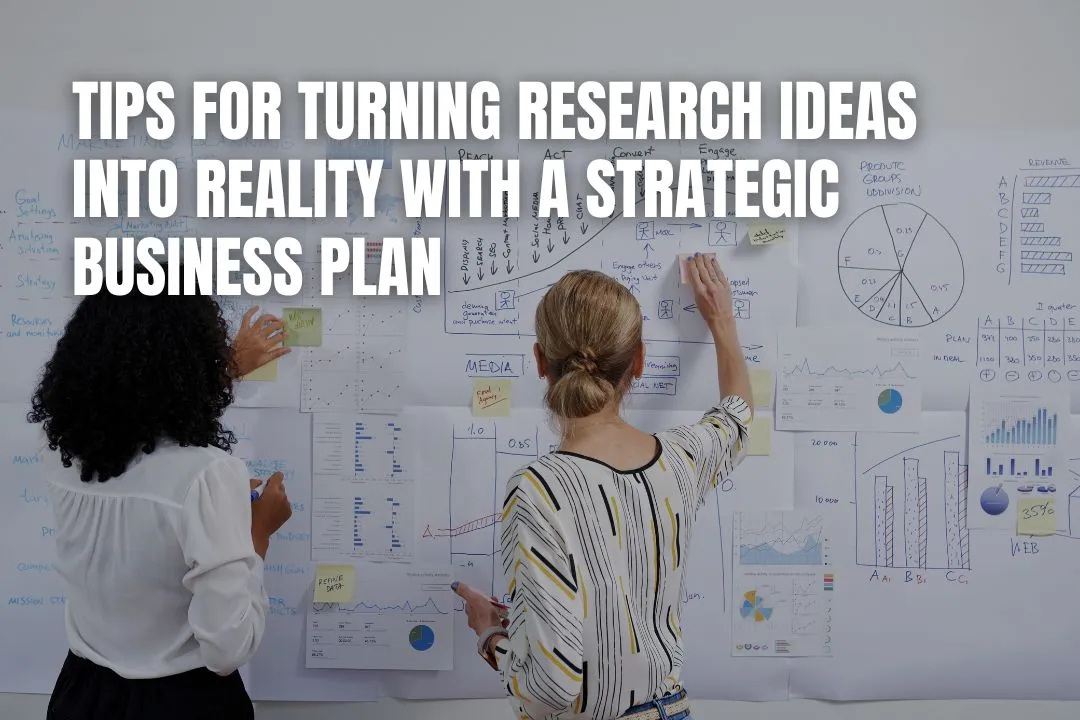
Establishing a research idea is only the first step on the innovation journey. Transforming that idea into a tangible solution requires an actionable approach that combines thorough planning with strategic execution. Developing a solid business plan helps in outlining your goals and in defining the resources, timelines, and methodologies vital for success. In this blog, actionable insights will be provided to help streamline the process of turning innovative research concepts into structured business initiatives.

Every successful project begins with a clear vision. This vision acts as a guiding star to navigate the complexities of research development. Clearly outline what you hope to achieve through your research. Take into account the implications of your findings and how they serve your target audience or market needs. A well-defined vision keeps the team aligned and motivated, creating a sense of purpose as they tackle challenges along the way.
Coupled with a strategic approach, this vision allows for adaptability while keeping the ultimate goal in focus. Solidifying the vision can involve performing a SWOT analysis to identify strengths, weaknesses, opportunities, and threats. This method offers insight into the competitive landscape and can highlight potential challenges that may arise. More importantly, it can clarify the unique selling proposition of the research project, setting it apart from existing offerings.
The success of any research initiative is contingent upon having the right tools and resources at hand. The equipment utilised in research settings is key to obtaining accurate and reliable results. In many scientific disciplines, the equipment can range from analytical instruments to software platforms designed for data collection and analysis. The team behind BMG LABTECH says that in lab settings, microplate readers are critical for accurate research, demonstrating how specific equipment can directly impact research quality. Selecting appropriate equipment encompasses assessing the specific requirements of the research project.
This can involve everything from analysing financial resource availability to ensuring that the equipment meets the technical and functional specifications necessary for your experiments. Accessible instruments enhance productivity and reduce the time needed for data collection and analysis. Investing in suitable resources can lead to valuable insights and groundbreaking discoveries.
When planning for equipment acquisition, think about the potential for collaboration with existing laboratories, academic institutions, or industry partners. Exploring these partnerships can alleviate financial burdens, yet open doors to a wider array of tools and technology that may not be readily available in-house.
The world of research is vast and often complex, making a strong network beneficial for navigating potential challenges. Building relationships with industry experts, professors, and fellow researchers can foster valuable collaborations that enrich your project.
Attending workshops, conferences, and industry events provides opportunities to meet influential figures in your field. As connections grow, trust can be built, paving the way for future partnerships and collaborations. Integrating mentorship into this network is equally important. Learning from those with more experience can provide insights not readily available from textbooks or online courses.
Mentorship can come in various shapes, from formal arrangements to informal coffee chats. Establishing these relationships can introduce new perspectives that drive innovation and keep your research fresh and relevant. Maintaining an active presence within your field, such as publishing articles or participating in discussions, can boost visibility and enhance credibility, which can prove valuable when seeking funding or partnerships.
Every research endeavour requires financial resources, which can be a major hurdle for many innovators. Identifying sources of funding beyond personal investment can provide the necessary capital to bring your research to fruition.
Government grants, private foundations, and corporate sponsorships are some avenues to explore, each with distinct eligibility criteria and funding opportunities. Grants are often available through public and private entities that support innovation in various fields. Understanding the specific requirements for submissions is important, as this can significantly improve the chances of securing funding.
Engaging with grant writers or colleagues with experience in proposal writing can enhance your project's appeal. Private investors are another potential source of funding. Pitching your vision to angel investors or venture capitalists can lead to substantial financial backing. When approaching investors, it's important to articulate the anticipated return on their investment clearly, demonstrating how your research can lead to profitable outcomes.
Tracking the progress of research initiatives is necessary for assessing performance and guiding future decision-making. Documenting research findings and methodologies provides a comprehensive record that can be referenced in future projects and submitted for publication. Regularly reviewing goals and outcomes strengthens accountability within a team.
Utilising management tools like Gantt charts or project management software facilitates tracking milestones and deadlines. Team members can provide input on challenges faced or successes achieved, allowing for real-time adjustments to be made when necessary. Creating a repository of your findings promotes an open exchange of ideas, elevating the quality of the work produced. It enhances transparency when soliciting feedback from mentors, peers, or stakeholders.

Once the research has been completed, the next vital step is sharing the findings with a broader audience. Marketing your research is instrumental in garnering interest and potentially leading to collaborations or real-world applications. Developing a strategic outreach plan includes creating promotional materials, such as posters, brochures, or dedicated websites.
These materials should communicate the significance of the research and its practical applications. Engaging with media outlets, whether through press releases, interviews, or articles, can vastly expand your reach. Connecting with journalists who specialise in your field will help facilitate this process.
Participating in webinars or speaking at industry events can showcase your work on a larger scale, attracting attention from various segments that may benefit from your research. Networking within the community often leads to unexpected opportunities. Reaching out to stakeholders who may have expressed interest in your project can foster discussions about potential implementation or commercialisation.
Successful research is a lightweight outcome driven by a focus on strategic planning. Each stage of the process, from defining a vision to marketing findings, deserves careful consideration and execution. By crafting a thorough business plan, researchers can turn innovative ideas into impactful solutions that resonate within their field.
A business plan is crucial because it provides a structured roadmap for your research. It helps you outline your goals, define the necessary resources and timelines, and create a clear path from an initial idea to a tangible, successful outcome.
To clarify your research vision, start by defining what you aim to achieve and who it will benefit. A great method is to perform a SWOT analysis (Strengths, Weaknesses, Opportunities, Threats) to understand the competitive landscape and identify your project's unique value.
You can explore several avenues for funding. Government grants, private foundations, and corporate sponsorships are popular options. You can also pitch your idea to private investors, such as angel investors or venture capitalists, by clearly showing the potential return on their investment.
Building a strategic network is very important. Connecting with industry experts, academics, and peers can lead to valuable collaborations, mentorship, and new perspectives. Attending conferences and workshops is an excellent way to build these vital relationships.
Consistently documenting your findings, methodologies, and outcomes is key. Using project management tools like Gantt charts can help you track milestones and deadlines, ensuring your team stays accountable and can make adjustments as needed.